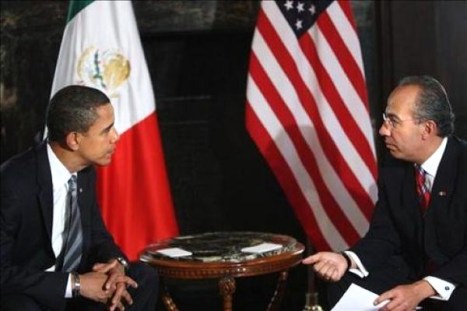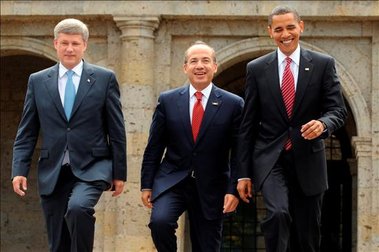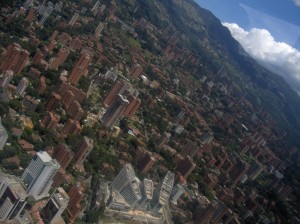
Obama and Calderon met in Mexico City on April 16
President Obama’s visit to Mexico has produced vague and contradictory statements, centered on worn-out strategies. Many people who had hoped for a new approach that would seek to redress the inequities of the binational relationship will find little in these declarations to pin their hopes on.
Obama began by enthusiastically endorsing President Felipe President Calderón. He expressed his “admiration” for Calderon’s “courage” in the increasingly bloody drug war and went so far as to promote Calderon’s bid to host the next UN Climate Change meeting.
These overtures no doubt served to decrease tensions between the two governments that built up following U.S. statements of the Mexico as a near “failed state” that was losing a grip on its own territory to drug cartels, and a potential national security threat. But by focusing the trip on the person of Calderón and seeking to bolster his leadership rating, Obama forgets that Calderón is a polemical president in a deeply divided nation as a result of both his rightwing policies and the doubts of legitimacy that hang over his presidency.
Obviously, Calderón is Obama’s formal counterpart but the unnecessary accolades rankle among the 50% of the population who felt defrauded by his court-determined ascendency to office. Note that Calderón did not spend time praising the person of Obama who, in fact, was not his preferred candidate in the 2008 elections.
The proposals held forth by the two presidents for the most part were either too vague to evaluate or did not respond to the needs of their respective publics. Calderón offered proposals to deepen NAFTA by building infrastructure on the border to increase economic flows, reforms in customs rules and elimination of tariff and non-tariff barriers. In doing so, he fell back on the debunked argument that by competing as a bloc in an unregulated global economy, both countries will someday enjoy prosperity. This at a time when that model has collapsed, leaving millions of people out of work on both sides of the border.
Meanwhile, Mexican peasant farmers who have been forced off their land by U.S imports were preparing a demonstration to call for renegotiation of the agricultural chapter of the agreement.
As predicted, both presidents confirmed their commitment to a militarized and unsuccessful “war on drugs” in Mexico. Obama did state that the binational relationship should not be defined only by security issues, but in terms of real programs–of putting one’s money where one’s mouth is–that remains the case. The Merida Initiative increased aid to Mexico tenfold in one area—security. This model, which employs the army to cut off the supply of illegal drugs, has no record of success in any part of the world. On the other hand, we know it causes extensive environmental damage, violence, displacement, violation of human rights and curtailment of civil liberties.
The energy and “green jobs” proposals were unclear. Mexicans are wary of proposals to commit energy resources in the way that the Canadians have had to under NAFTA and there is also considerable criticism of carbon markets as a market-based alternative to needed regulation on polluting emissions.
The bright spot on the horizon of this troubled US-Mexico relations is the issue of immigration. Obama reiterated his commitment to legalization of Mexican undocumented workers established north of the border, while paying some penalties. Recent news stories indicate that he is moving on this commitment. Calderón offered no concrete proposals to generate or preserve jobs in areas of high expulsion nor did Obama offer proposals in this crucial area.
Up to now, both have avoided controversial issues—the renegotiation of NAFTA, corruption, inequality or, directly, the economic crisis. They did not speak of specific measures to generate employment in Mexico or alleviate the crushing poverty that affects millions of Mexican families.
The involvement of the U.S. government in Mexico’s national security apparatus, advanced through the Merida Initiative–the military and police aid package designed by the Bush administration and passed by Congress, raises sensitive issues of sovereignty. Tagging on measures within the U.S. does not erase those fears or the ill-conceived emphasis on Mexico’s part of the transnational problem.
Likewise, good intentions and empty declarations do not resolve the problem of the profound asymmetries and inequalities locked in by NAFTA that feed migration from Mexico to the U.S.
These issues will be a part of the agenda at the Summit of the Americas. There, the alternatives to corporate-led globalization that are being developed throughout the hemisphere will have a central place, putting into relief the failure of the old models.
Presidents Obama and Calderon have an obligation to revise their proposals and seek a “new era” that really responds to the multiple crises—economic, financial, environmental, social and security—that characterize this moment in the binational relationship.





